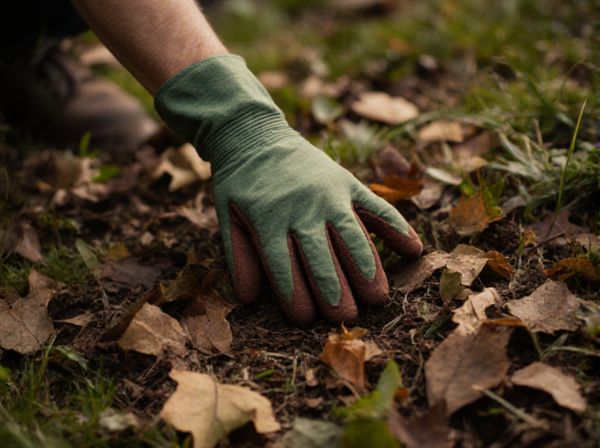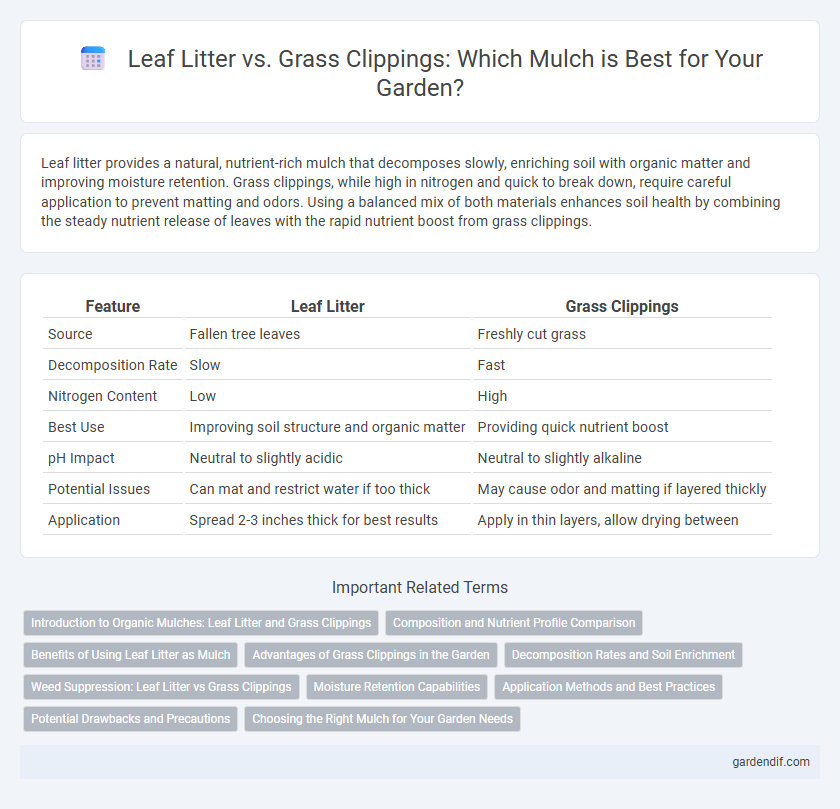
Leaf litter vs Grass clippings Illustration
Leaf litter provides a natural, nutrient-rich mulch that decomposes slowly, enriching soil with organic matter and improving moisture retention. Grass clippings, while high in nitrogen and quick to break down, require careful application to prevent matting and odors. Using a balanced mix of both materials enhances soil health by combining the steady nutrient release of leaves with the rapid nutrient boost from grass clippings.
Table of Comparison
| Feature | Leaf Litter | Grass Clippings |
|---|---|---|
| Source | Fallen tree leaves | Freshly cut grass |
| Decomposition Rate | Slow | Fast |
| Nitrogen Content | Low | High |
| Best Use | Improving soil structure and organic matter | Providing quick nutrient boost |
| pH Impact | Neutral to slightly acidic | Neutral to slightly alkaline |
| Potential Issues | Can mat and restrict water if too thick | May cause odor and matting if layered thickly |
| Application | Spread 2-3 inches thick for best results | Apply in thin layers, allow drying between |
Introduction to Organic Mulches: Leaf Litter and Grass Clippings
Leaf litter and grass clippings are two common types of organic mulches that enhance soil health by adding essential nutrients and improving moisture retention. Leaf litter decomposes slowly, providing a long-term nutrient release and better aeration, while grass clippings break down quickly, supplying a rapid nitrogen boost ideal for fast-growing plants. Both materials contribute to weed suppression, temperature regulation, and fostering beneficial microbial activity in garden ecosystems.
Composition and Nutrient Profile Comparison
Leaf litter mulch is rich in carbon and decomposes slowly, providing long-term soil aeration and organic matter, whereas grass clippings are high in nitrogen and break down quickly, supplying rapid nutrient release. Leaf litter typically contains lower nitrogen content with higher lignin and cellulose, enhancing soil structure over time, while grass clippings offer a balanced mix of nitrogen, phosphorus, and potassium essential for immediate plant growth. Combining both mulches can optimize soil fertility by balancing carbon-to-nitrogen ratios and improving overall nutrient cycling in garden ecosystems.
Benefits of Using Leaf Litter as Mulch
Leaf litter as mulch enhances soil fertility by decomposing slowly, releasing essential nutrients such as nitrogen, phosphorus, and potassium that promote healthy plant growth. Unlike grass clippings, leaf litter improves soil structure and moisture retention, reducing erosion and suppressing weed growth effectively. Its diverse organic matter supports beneficial microbial activity, fostering a balanced ecosystem within the garden soil.
Advantages of Grass Clippings in the Garden
Grass clippings provide a rich source of nitrogen that accelerates soil nutrient cycling, enhancing plant growth more effectively than leaf litter. Their high moisture content helps retain soil hydration, reducing the need for frequent watering. Unlike leaf litter, grass clippings decompose rapidly, promoting quicker organic matter integration and improved soil fertility in the garden.
Decomposition Rates and Soil Enrichment
Leaf litter decomposes more slowly than grass clippings due to its higher lignin content, providing a gradual release of nutrients over time. Grass clippings break down rapidly, supplying immediate nitrogen to the soil, which enhances microbial activity and promotes faster plant growth. Combining both materials in mulch optimizes soil enrichment by balancing quick nutrient availability with sustained organic matter contribution.
Weed Suppression: Leaf Litter vs Grass Clippings
Leaf litter provides superior weed suppression compared to grass clippings due to its dense, layered structure that blocks sunlight and inhibits weed seed germination. Grass clippings decompose quickly, offering limited physical coverage and allowing more sunlight to reach weed seeds. Using leaf litter as mulch creates a longer-lasting barrier against weed growth, enhancing garden health and reducing maintenance.
Moisture Retention Capabilities
Leaf litter excels in moisture retention due to its thicker, more fibrous structure, which slows evaporation and maintains soil hydration longer than grass clippings. Grass clippings decompose quickly, providing a temporary moisture barrier but requiring frequent replenishment to sustain soil dampness. Using leaf litter as mulch improves water conservation efficiency in garden beds and reduces irrigation needs effectively.
Application Methods and Best Practices
Leaf litter mulch is best applied by shredding leaves to accelerate decomposition and evenly spreading a 2-3 inch layer around plants, ensuring it does not pile against stems to prevent rot. Grass clippings should be used sparingly as mulch because they can mat and create odor if applied too thickly; applying thin layers and mixing with other materials improves aeration and nutrient release. Both mulches benefit from periodic turning or incorporation into the soil to maintain moisture balance and microbial activity.
Potential Drawbacks and Precautions
Leaf litter may harbor pests and diseases if not properly composted, requiring precautions like thorough drying or shredding before use as mulch. Grass clippings can create an anaerobic environment and produce unpleasant odors if applied too thickly or wet, necessitating careful layering and mixing with dry materials. Both materials demand monitoring of moisture levels to prevent mold growth and nutrient imbalances in the soil.
Choosing the Right Mulch for Your Garden Needs
Leaf litter provides a nutrient-rich, natural mulch that improves soil structure and moisture retention, ideal for garden beds and trees. Grass clippings decompose quickly, supplying a high nitrogen content that promotes vigorous plant growth, making them suitable for vegetable gardens and lawns. Selecting between leaf litter and grass clippings depends on your garden's specific nutrient needs and desired mulch longevity to optimize plant health and soil fertility.
Leaf litter vs Grass clippings Infographic

 gardendif.com
gardendif.com